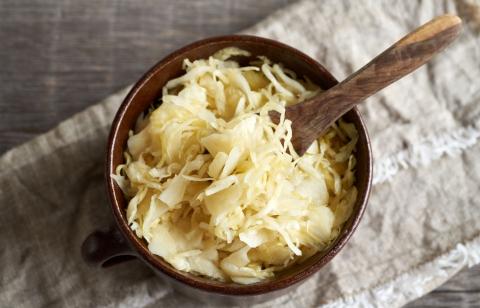Fermenting: Safe Food Preservation (PLUS a Sauerkraut Recipe!)
Fermentation of food and beverages has been around for centuries as a safe way to preserve food. Fermenting is the process by which beneficial bacteria break down food under conditions that improve the taste, texture, and shelf life of the food or beverage. It is important to maintain a high level of cleanliness before and during the process, follow research-tested procedures, and ferment under ideal conditions to obtain the safest, best quality product.
After fermentation is complete, store products in the refrigerator or store products in a cool, dry place if they have been safely canned. Shelf life for frozen and refrigerated fermented foods depends on the food and based on quality. For canned foods, most properly home-canned products are of the best quality for up to one year.
As with all low-acid vegetables, do the following when cucumbers are made into fermented dill pickles:
Do not alter vinegar, food, or water proportions in a recipe or use vinegar with unknown acidity. Use vinegar with 5% acidity.
Use only recipes with tested proportions of ingredients.
There must be a minimum, uniform level of acid throughout the mixed product to prevent the growth of clostridium botulinum bacteria.
USDA has two research-tested recipes for fermented foods – dill pickles and sauerkraut, which are included in the sources below.
Recipe: Sauerkraut

Ingredients
25 lbs. cabbage
3/4 cup canning or pickling salt
Quality: For the best sauerkraut, use firm heads of fresh cabbage. Shred cabbage and start kraut between 24 and 48 hours after harvest.
Yield: About 9 quarts
Procedure: Work with about 5 pounds of cabbage at a time. Discard outer leaves. Rinse heads under cold running water and drain. Cut heads in quarters and remove cores. Shred or slice to a thickness of a quarter. Put cabbage in a suitable fermentation container, see "Suitable Containers, Covers, and Weights for Fermenting Food," and add 3 tablespoons of salt. Mix thoroughly, using clean hands. Pack firmly until salt draws juices from cabbage. Repeat shredding, salting, and packing until all cabbage is in the container. Be sure it is deep enough so that its rim is at least 4 or 5 inches above the cabbage. If juice does not cover cabbage, add boiled and cooled brine (1-1/2 tablespoons of salt per quart of water). Add plate and weights, cover container with a clean bath towel.
Sauerkraut fermentation can take place under variable temperature and time combinations. For obtaining a good quality sauerkraut at home, the USDA recommendation is to store at 70º to 75ºF while fermenting. At temperatures between 70º and 75ºF, kraut will be fully fermented in about 3 to 4 weeks; at 60º to 65ºF, fermentation may take 5 to 6 weeks. At temperatures lower than 60ºF, kraut may not ferment. Above 75ºF, kraut may become soft.
If you weigh the cabbage down with a brine-filled bag, do not disturb the crock until normal fermentation is completed (when bubbling ceases). If you use jars as weight, you will have to check the kraut 2 to 3 times each week and remove scum if it forms. Fully fermented kraut may be kept tightly covered in the refrigerator for several months or it may be canned as follows:
Hot pack – Bring kraut and liquid slowly to a boil in a large kettle, stirring frequently. Remove from heat and fill jars rather firmly with kraut and juices, leaving 1/2-inch headspace.
Raw pack – Fill jars firmly with kraut and cover with juices, leaving 1/2-inch headspace.
Adjust lids and process according to the recommendations in Table 1 of NCHFP's fermenting recipe for sauerkraut.
| Table 1. Recommended process time for Sauerkraut in a boiling-water canner. | |||||
Process Time at Elevations of | |||||
| Style of Pack | Jar Size | 0 - 1,000 ft | 1,001 - 3,000 ft | 3,001 - 6,000 ft | Above 6,000 ft |
| Hot | Pints | 10 min | 15 | 15 | 20 |
| Quarts | 15 | 20 | 20 | 25 | |
| Raw | Pints | 20 | 25 | 30 | 35 |
| Quarts | 25 | 30 | 35 | 40 | |
Recipe: National Center for Home Food Preservation / Fermenting / Recipes / Sauerkraut. This document was adapted from the "Complete Guide to Home Canning," Agriculture Information Bulletin No. 539, USDA, revised 2015.
Sources:
National Center for Home Food Preservation – Fermenting
Background information and recipes for fermented dill pickles and sauerkraut
Penn State Let's Preserve: Fermentation - Sauerkraut and Pickles
Background information and recipes for fermented sauerkraut and pickles
Illinois Extension Food Preservation – Fermentation
Informational, no recipes
Photo of Homemade Fermented Vegetables by Microgen on stock.adobe.com
Photo of Sauerkraut by Madeleine Steinbach on stock.adobe.com

